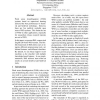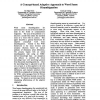250 search results - page 4 / 50 » Learning Probabilistic Models of Word Sense Disambiguation |
NLDB
2007
Springer
13 years 11 months ago
2007
Springer
Word sense disambiguation is the task to identify the intended meaning of an ambiguous word in a certain context, one of the central problems in natural language processing. This p...
CORR
2004
Springer
13 years 5 months ago
2004
Springer
This paper describes the National Research Council (NRC) Word Sense Disambiguation (WSD) system, as applied to the English Lexical Sample (ELS) task in Senseval-3. The NRC system ...
ACL
2010
13 years 3 months ago
2010
Word sense disambiguation (WSD) systems based on supervised learning achieved the best performance in SensEval and SemEval workshops. However, there are few publicly available ope...
ACL
1998
13 years 6 months ago
1998
Word sense disambiguation for unrestricted text is one of the most difficult tasks in the fields of computational linguistics. The crux of the problem is to discover a model that ...
COLING
2008
13 years 6 months ago
2008
We propose a supervised word sense disambiguation (WSD) method using tree-structured conditional random fields (TCRFs). By applying TCRFs to a sentence described as a dependency t...


